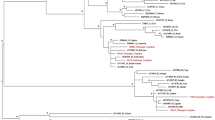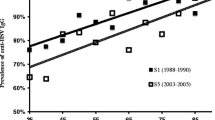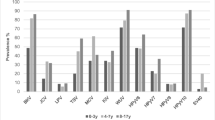Abstract
Human herpesvirus-6 (HHV-6) can be regularly isolated from peripheral blood mononuclear cells (PBMC) of children suffering from exanthema subitum, but only rarely from PBMC of adults. Although the high prevalence of HHV-6 infection in early childhood seems to result from cell-free infectious virus shedded in saliva of healthy adults, latent HHV-6 infection is supposed to occur in lymphocytes. Therefore, we performed polymerase chain reaction (PCR) with DNA from PBMC of 44 healthy adults, 31 HIV-seropositive individuals and 33 patients with leukaemia or lymphoproliferative disorders. As positive control served PBMC from 11 children with exanthema subitum and as negative control PBMC from 20 newborns. Whereas HHV-6-specific sequences were detected in PBMC from all children with exanthema subitum and never in PBMC from newborns, they were found in PBMC of 9% of healthy adults and HIV-seropositive individuals and in 16% of the patients with lymphoproliferative disorders. Apparently detection of HHV-6 DNA in PBMC was neither limited by low sensitivity of the HHV-6 PCR assay, which detected less than ten copies of cloned HHV-6 DNA, nor by a low rate of latently infected individuals, but was limited by the number of lymphocytes subjected to PCR. It is supposed that the presence of latent HHV-6 DNA in lymphocytes is common, but that infected lymphocytes are rare (≤1 infected cell in 105 lymphocytes).Although the results do not support a definite propagation of HHV-6 in HIV-seropositive individuals or in patients with leukaemia or lymphoproliferative disorders, they cannot exclude HHV-6 acting as co-factor in HIV infection or in lymphoproliferative disorders.
Similar content being viewed by others
References
Ablashi DV, Josephs SF, Buchbinder A, Hellman K, Nakamura S, Llana T, Lusso P, Kaplan M, Dahlberg J, Memon S, Imam F, Ablashi KL, Markham PD, Kramarsky B, Krueger GRF, Biberfeld P, Wong-Staal F, Salahuddin SZ, Gallo RC (1988) Human B-lymphotropic virus (human herpesvirus-6). J Virol Methods 21:29–48
Asano Y, Yoshikawa T, Suga S, Yazaki T, Hata T, Nagai T, Kajita Y, Ozaki T, Yoshida S (1989) Viremia and neutralizing antibody response in infants with exanthema subitum. J Pediatr 114:535–539
Becker WB, Engelbrecht S, Becker MLB, Piek C, Robson BA, Wood L, Jacobs P (1988) New T-lymphotropic human herpesviruses. Lancet I:41
Biberfeld P, Petren AL, Eklund A, Lindemalm C, Barkhem T, Ekman M, Ablashi D, Salahuddin Z (1988) Human herpesvirus 6 (HHV-6, HBLV) in sarcoidosis and lymphoproliferative disorders. J Virol Methods 21:49–51
Clark DA, Alexander FF, McKinney PA, Roberts BE, O'Brien C, Jarett RF, Cartwright RA, Onions DE (1990) The seroepidemiology of human herpesvirus-6 (HHV-6) from a case control study of leukaemia and lymphoma. Int J Cancer 45:829–833
Downing RG, Sewankambo N, Serwadda D, Honess R, Crawford D, Jarett R, Griffin BE 1987 Isolation of human lymphotropic herpesvirus from Uganda. Lancet II:390
Ensoli B, Lusso P, Schachter F, Josephs SF, Rappaport J, Negro F, Gallo RC, Wong-Staal F (1989) Human herpes virus-6 increases HIV-1 expression in co-infected T cells via nuclear factors binding to the HIV-1 enhancer. EMBO J 8:3019–3027
Fox JD, Briggs M, Ward PA, Tedder RS (1990) Human herpesvirus 6 in salivary glands. Lancet II:590–593
Gopal MR, Thomson BJ, Fox J, Tedder RS, Honess RW (1990) Detection by PCR of HHV-6 and EBV DNA in blood and oropharynx of healthy adults and HIV-seropositives. Lancet I:1598–1599
Harnett GB, Farr TJ, Pietroboni GR, Bucens MR (1990) Frequent shedding of human herpesvirus 6 in saliva. J Med Virol 30:128–130
Horvat RT, Wood C, Balachandran N (1989) Transactivation of human immunodeficiency virus promoter by human herpesvirus 6. J Virol 63:970–973
Jarett RF, Clark DA, Josephs SF, Onions DE (1990) Detection of human herpesvirus-6 DNA in peripheral blood and saliva. J Med Virol 32:73–76
Josephs SF, Buchbinder A, Streicher HZ, Ablashi DV, Salahuddin SZ, Guo HG, Wong-Staal F, Cossman J, Sundeen J, Levine P, Biggar R, Krueger GRF, Fox RI, Gallo RC (1988) Detection of human B-lymphotropic virus (human herpesvirus 6) sequences in B cell lymphoma tissue of three patients. Leukemia 2:132–135
Kondo K, Hayakawa Y, Mori H, Sato S, Kondo T, Takahashi M, Yamanishi K (1990) Detection by polymerase chain reaction amplification of human herpesvirus 6 DNA in peripheral blood of patients with exanthema subitum. J Clin Microbiol 28:970–974
Krueger GRF, Sander C (1989) What's new in human herpesvirus-6? Clinical immunopathology of the HHV-6 infection. Pathol Res Pract 185:915–929
Krueger GRF, Koch B, Ramon A, Ablashi DV, Salahuddin SZ, Josephs SF, Streicher HZ, Gallo RC, Habermann U (1988) Antibody prevalence to HBLV (human herpesvirus-6, HHV-6) and suggestive pathogenicity in the general population and in patients with immune deficiency syndromes. J Virol Methods 21 125–132
Lawrence GL, Chee M, Craxton MA, Gompels UA, Honess RW, Barell BG (1990) Human herpesvirus 6 is closely related to human cytomegalovirus. J Virol 64:287–299
Levy JA, Ferro F, Greenspan D, Lennette ET (1990) Frequent isolation of HHV-6 from saliva and high seroprevalence of the virus in the population. Lancet 335:1047–1050
Lopez C, Pellett P, Stewart J, Goldsmith C, Sanderlin K, Black J, Warfield D, Feorino P (1988) Characteristics of human herpesvirus 6. J Infect Dis 157:1271–1273
Lusso P, Ensoli B, Markham PD, Ablashi DV, Salahuddin SZ, Tschachler E, Wong-Staal F, Gallo RC (1989) Productive dual infection of human CD4+ T lymphocytes by HIV-1 and HHV-6. Nature 337:370–373
Miller SA, Dykes DD, Polesky HF (1988) A simple salting out procedure for extracting DNA from human nucleated cells. Nucleic Acids Res 16:1215
Neff J (1990) Seroepidemiologische Untersuchungen mit Kinderseren unter Verwendung von zwei verschiedenen Stämmen von humanem Herpesvirus-6. Thesis, Medical Faculty, University of Bonn
Portolani M, Cermelli C, Pietrosemoli P, Pecorari M, Farabegoli F, Cavazzuti GB, Bertolani MF, Micheli A (1990) Isolation of HHV-6-related virus from children affected by infectious syndrome. Arch Virol 110:143–149
Salahuddin SZ, Ablashi DV, Markham PD, Josephs SF, Sturzenegger S, Kaplan M, Halligan G, Biberfeld P, Wong-Staal F, Kramarsky B, Gallo RC (1986) Isolation of a new virus, HBLV, in patients with lymphoproliferative disorders. Science 234:596–601
Schneweis KE, Kleim JP, Bailly E, Niese D, Wagner N, Brackmann HH (1990) Graded cytopathogenicity of human immunodeficiency virus (HIV) in the course of HIV infection. Med Microbiol Immunol 179:193–203
Takahashi K, Sonoda S, Kawakami K, Miyata M, Oki T, Nagata T, Okuno T, Yamanishi K (1988) Human herpesvirus 6 and exanthema subitum. Lancet I:1463
Tedder RS, Briggs M, Cameron CH, Honess R, Robertson D, Whittle H (1987) A novel lymphotropic herpesvirus. Lancet II:390–392
Yamanishi K, Okuno T, Shiraki K, Takahashi M, Kondo T, Asano Y, Kurata T (1988) Identification of human herpesvirus-6 as a causal agent for exanthema subitum. Lancet I:1065–1067
Author information
Authors and Affiliations
Rights and permissions
About this article
Cite this article
Sandhoff, T., Kleim, JP. & Schneweis, K.E. Latent human herpesvirus-6 DNA is sparsely distributed in peripheral blood lymphocytes of healthy adults and patients with lymphocytic disorders. Med Microbiol Immunol 180, 127–134 (1991). https://doi.org/10.1007/BF00206116
Received:
Issue Date:
DOI: https://doi.org/10.1007/BF00206116




